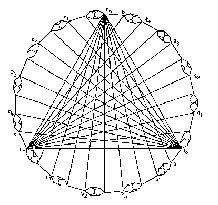 Diagram from the Kochen-Specker paper (1967)
Diagram from the Kochen-Specker paper (1967)home
Properties in quantum mechanics
The concept of "properties" is more subtle than one might expect. While this complications have nothing to do with quantum mechanice, here the notion of "something" having a "property" gets more sophisticated still.
Some definitions
Quantum oddities aside, the notion of a "property" allows for reasonable distinctions. Let us look at the following "properties":
- "being round"
- "being the son of"
- "being soluble"
- intrinsic properties (as opposed to relational or extrinsic properties)
- categorical properties (as opposed to dispositional properties)
As indicated above, these two property types (together with their antonyms) are logically independent: you find intrisically possesed dispositions (a window being fragile even in the absence of stones or other objects that may shatter it) or intrinsically possesed categorical properties (like our "being round"). At the same time a relational property can be non-dispositional (like our "being the son of"-example) or dispositional (like "being more fragile than something else").
Properties and Phsics
The relation between physics and "properties" is a close one! Physics may even be construed as the quest (i) to identify properties (mass, energy, charge, ...) and (ii) to establish law-like relations between them. Let us try to apply our above terminology to physics. "Mass" would be a good example for an intrinsic (and categorical) property, while "weight" is a "relational" or "extrinsic" property: it reflects the way a (massive) object interacts with the world. But what about dispositions? Physics or science in general is full of them, as the above mentioned examples "fragile" or "soluble" show. However, this properties (e.g. "fragile") are usually explained in terms of the atomic or molecular structure of the material. In other words, dispositions are traced back to categorical properties!
Quantum mechanics, contextuality and properties
In QM a state has only a certain value of an "observable" if it happens to be in an eigenstate of the corresponding operator. This leads to the well known fact, that quantum mechanics does not allow for a consistent assignment of states and "possessed values" of arbitrary observables. If the corresponding operators do not commute this follows directly from the absence of a common basis of eigenvectors (and is the bases for Heisenberg's uncertainty relation). However the Kochen-Specker theorem (1967) makes an ever stronger claim. Even if A commutes with the operators (A,B,C) and (A,D,E), does a consistent possesed value assignment for A fails, if the operators (B,C,D,E) do not mutually commute. That the value of A depends on it being measured together with (B,C) or (D,E) has been named "contextuality".
It has been suggested by Dorato, that properties in QM - given their contextualiy - can be identified with dispositional properties. The (e.g. measurement-) context influences the possible properties of a quantum state. Like salt has the dispositions to disolve in water, a silver atom has the disposition to be deflected in the magnetic field of a Stern-Gerlach apparatus. However, and that is the specific "quantumness" of these properties, there is no such thing like a "categorical" basis for these dispositions!
Annotated references
In "Properties and Dispositions: some Metaphysical Remarks on Quantum Ontology" (2006) and "Dispositions, Relational Properties and the Quantum World" (2003) Mauro Dorato compares different interpretation of quantum mechanics with respect to the status of "properties" and how they deal with contextuality. He essentially identifies the "contextuality" of a (quantum-)property with being dispositional.
In "Unremarkable contextualism: Dispositions in the Bohm theory" (Found.Phys. Vol 25, Number 2 (1995) 281-296.) by Pagonis and Clifton deals with property assignment within the de Broglie-Bohm theory.